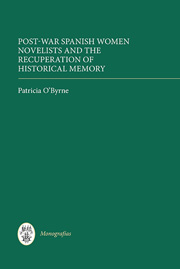Book contents
- Frontmatter
- Dedication
- Contents
- Acknowledgements
- Preface
- Introduction
- 1 Spanish Women Novelists 1940–1960
- 2 Work and Religion: a Right-wing Perspective
- 3 Sexual Abuse and Male Dominion
- 4 Spinsters in Post-war Spain
- 5 Exemplary Mothers and Sexually Liberated Women
- 6 Prostitution, Sexual Ignorance and Sex Outside Marriage
- Afterword
- Works Cited
- Index
1 - Spanish Women Novelists 1940–1960
Published online by Cambridge University Press: 05 August 2014
- Frontmatter
- Dedication
- Contents
- Acknowledgements
- Preface
- Introduction
- 1 Spanish Women Novelists 1940–1960
- 2 Work and Religion: a Right-wing Perspective
- 3 Sexual Abuse and Male Dominion
- 4 Spinsters in Post-war Spain
- 5 Exemplary Mothers and Sexually Liberated Women
- 6 Prostitution, Sexual Ignorance and Sex Outside Marriage
- Afterword
- Works Cited
- Index
Summary
En ninguna época de la historia de España se han publicado tantas novelas firmadas por mujeres como en las tres décadas que abarcan de los años de cuarenta a sesenta. … Es un fenómeno que no está estudiado … pero en la prensa de la época se encuentran muchos testimonios, unos burlescos, otros más o menos comprensivos, y la mayoría indignados, que lo registran como una novedad incontestable.
[In no period in the history of Spain have so many novels been published by women authors than in the three decades from the 1940s to the 1960s. … This is a development that has not been studied … but in the periodicals of the times it receives much coverage, some facetious, some more or less sympathetic but in most cases expressing indignation, but recording it unequivocally as a new departure.]
The post-war novelist Carmen Martín Gaite was one of the first to record the emergence of significant numbers of women novelists in the 1940s, 1950s and 1960s. Since then, most critics of twentieth-century women novelists' literature refer to the boom in Spain in the 1970s and again in the 1990s, but as Carmen Urioste points out, reinforcing Martín Gaite's observation, the 1990s' generation represents the third emergence of significant numbers of women writers. Critics (most of whom are women) who write about the apparition of scores of female novelists from the 1940s through to the mid-1960s all concur on the failure of literary histories to absorb this departure (Janet Pérez, 1983, 1988; Concha Alborg, 1993; Elena Soriano, 1993; Francisca López, 1995; Raquel Conde Peñalosa, 2004; Nino Kebadze, 2009; Kyra A. Kietrys and Montserrat Linares, 2009).
- Type
- Chapter
- Information
- Publisher: Boydell & BrewerPrint publication year: 2014

